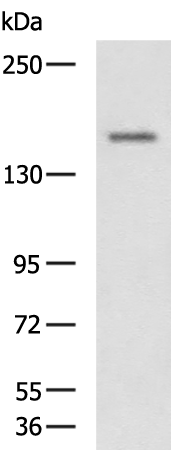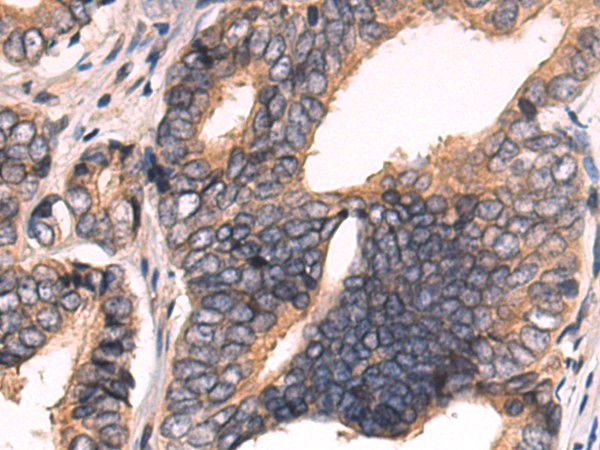

| WB | 咨询技术 | Human,Mouse,Rat |
| IF | 咨询技术 | Human,Mouse,Rat |
| IHC | 1/50-1/200 | Human,Mouse,Rat |
| ICC | 技术咨询 | Human,Mouse,Rat |
| FCM | 咨询技术 | Human,Mouse,Rat |
| Elisa | 1/5000-1/10000 | Human,Mouse,Rat |
| Aliases | MAST1 |
| WB Predicted band size | 169 kDa |
| Host/Isotype | Rabbit IgG |
| Antibody Type | Primary antibody |
| Storage | Store at 4°C short term. Aliquot and store at -20°C long term. Avoid freeze/thaw cycles. |
| Species Reactivity | Human, Mouse |
| Immunogen | Fusion protein of human CLASP1 |
| Formulation | Purified antibody in PBS with 0.05% sodium azide and 50% glycerol. |
+ +
以下是关于CLASP1抗体的3篇参考文献,包含文献名称、作者及摘要内容概括:
1. **文献名称**:*"CLASP1 and CLASP2 bind to EB1 and regulate microtubule plus-end dynamics at the cell cortex"*
**作者**:Mimori-Kiyosue Y, et al.
**摘要**:该研究通过免疫荧光和活细胞成像技术,使用CLASP1抗体揭示了CLASP1与EB1蛋白的相互作用,及其在细胞皮层微管正端动态调控中的作用,表明CLASP1对细胞极性和迁移至关重要。
2. **文献名称**:*"Distinct roles of CLASP1 and CLASP2 in mitotic spindle organization"*
**作者**:Maiato H, et al.
**摘要**:作者利用CLASP1特异性抗体进行免疫沉淀和功能抑制实验,发现CLASP1在有丝分裂纺锤体组装中调控微管锚定,其缺失导致染色体排列异常,提示其在细胞分裂中的关键功能。
3. **文献名称**:*"CLASP1 interacts with the Arp2/3 complex to regulate cell migration and adhesion"*
**作者**:Drabek K, et al.
**摘要**:通过Western blot和共聚焦显微镜结合CLASP1抗体,研究发现CLASP1通过与Arp2/3复合物互作协调微管与肌动蛋白网络,影响细胞迁移和黏着斑稳定性,为癌症转移机制提供新见解。
CLASP1 (cytoplasmic linker-associated protein 1) is a microtubule-associated protein critical for regulating microtubule dynamics, cell polarity, and intracellular transport. It belongs to the CLASP family, which interacts with the cytoskeleton to stabilize microtubules at specific subcellular regions, such as the cell cortex or Golgi apparatus. CLASP1’s activity is tightly regulated by signaling pathways, including the Wnt/GSK3β pathway, enabling it to coordinate microtubule behavior with cellular signaling cues. Its roles span mitosis, cell migration, and neuronal development, where it ensures proper spindle orientation, directional movement, and axon guidance.
CLASP1 antibodies are essential tools for studying these processes. They are widely used in techniques like immunofluorescence, Western blotting, and immunoprecipitation to localize CLASP1. assess expression levels, or identify binding partners. Researchers also utilize these antibodies to investigate CLASP1’s involvement in diseases; dysregulation of CLASP1 has been linked to cancer metastasis (via enhanced cell invasiveness) and neurological disorders (due to impaired neuronal transport). Specific antibodies may target distinct isoforms or post-translational modifications, aiding in functional studies of CLASP1 variants. Validation of CLASP1 antibodies often includes knockout controls or siRNA knockdown to confirm specificity. Overall, CLASP1 antibodies provide critical insights into cytoskeletal regulation and its pathological disruptions.
×